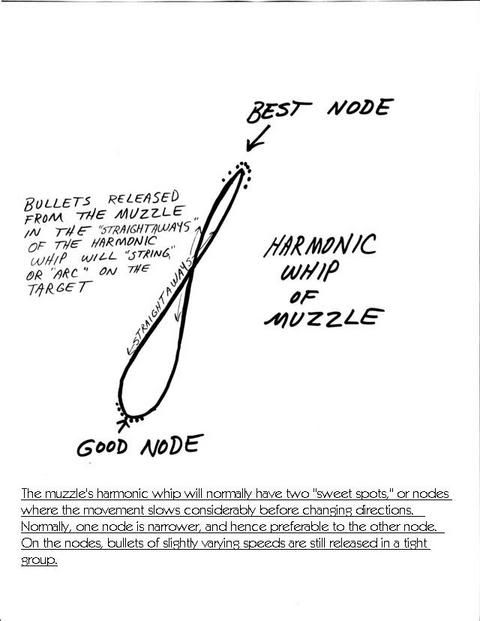The barrel's vibration pattern is set into motion by the shock wave (Chris Long has identified this wave, and charted its behavior). Long also calls it the "acoustic wave" because that's of course what it is. It moves at the speed of sound in steel, beginning at the chamber and going to the end of the barrel, reversing and repeating--at 18,000 fps. So this wave makes its first round trip before the bullet even gets its boots on.

An OCW load will accelerate the bullet at such a rate that the shock wave is not at the muzzle when the bullet is released. The shock wave will obturate the bore, and in other additional ways disturb the bullet's release from the muzzle. When you see what I call the "scatter node" in an OCW test, this is the point at which the shock wave is *at* the muzzle on bullet release, and the group is obviously worse than the rest of the groupings on the continuum.
The vibration pattern that this shock wave induces is a separate thing from the wave itself. The vibration pattern a barrel makes (as its muzzle traces through the air) is unique to that barrel; in this way all barrels will be different. If the bullets release as this vibration pattern is reaching an extreme end (just before reversing to move the other way) you get great accuracy, as the muzzle is sitting nearly still for a very short period of time then... all bullets between two muzzle velocity parameters (high and low) will be released into the same point in space, and will presumably (all else being equal) go to the same place, which is of course what you want.
Once you get the right OCW powder charge, your groups should be pretty decent without doing any seating depth adjustments (unless you're using a bullet known for seating depth sensitivity). Realize that great performing factory match ammo does not enjoy the benefit of being tuned to a specific distance from the barrel's lands. These are simply OCW loads that work in most all rifles, regardless of DTL (distance to lands).
Adjusting the seating depth of the bullet *after* you discover the OCW is the right way to go about things (in my opinion). This will allow you to take full advantage of the depth of the accuracy node as far as keeping the bullets exiting when the shock wave is well away from the muzzle, while at the same time "depth tuning" the load so that the bullets will exit the muzzle during the favorable window of opportunity on the vibration pattern. After doing this, your cold, clean bore shots will stay much closer to (and often won't deviate at all) from group center.
So a subtle change to the rifle ought not change the OCW itself, but it could potentially change the barrel's vibration pattern a bit, perhaps necessitating a small seating depth change to really get the load tight. You'll often need to do the same thing when you change bullet lots, too.
Crude drawing alert...


You could move the bullet's exit to a more favorable part of the vibration pattern with a tiny change in the powder charge, but if you properly identified the OCW in the initial test, you'll be moving away from the OCW center just a bit, and bullets may end up exiting the muzzle with the shock wave being closer to the muzzle. I like to tweak the seating depth a bit in situations where a small change to the system (such as a bullet lot change, new brass, or rifle stock change) harms accuracy.
Dan



